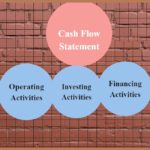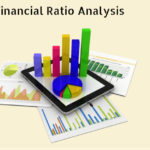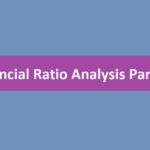The Leverage Ratios
We talked about financial leverage while discussing return on equity and DuPont analysis. Leverage is used like a double-edged sword.
The best companies take loans, especially when they see that they can make more money from the loan money than the interest they pay on the loan. You know that the asset created through debt also increases returns and equity.
But when the company takes a lot of debt, then due to interest on the loan, the profit accruing to the shareholder gets reduced. That is why there is very little difference between a good and a bad loan. Leverage ratio tells us how much debt a company has and its debt position.
We will look at the following leverage ratios:
- Interest Coverage Ratio
- Debt to Equity Ratio
- Debt to Asset Ratio
- Financial Leverage Ratio
So far we have used Amara Raja Batteries Limited (ARBL) as an example. But to understand leverage better, we need a company that has a lot of debt on its balance sheet. That’s why I have chosen Jain Irrigation Systems Ltd. You can also use the company of your choice.
Interest coverage ratio
The interest coverage ratio is sometimes also called the Debt Service Ratio or Debt Service Coverage Ratio. The interest coverage ratio tells us how much a company is earning relative to its debt load. This tells us how easily the company can pay its interest. For example, if the company has a debt of Rs 100 and earnings of Rs 400, we can easily see that the company has enough money to pay off its debt. But if the interest coverage ratio is low, it means that the company has a high debt burden and the company is more likely to go bankrupt.
Formula to calculate interest coverage ratio:
Earnings Before Interest & Tax / Interest Payment
Earning Before Interest and Tax (EBIT) =
EBITDA – Depreciation and Amortization
Jain uses this ratio at Irrigation Systems Ltd. The image below shows the P&L Statement of Jain Irrigation Systems for FY14. I have highlighted the finance cost of the company in red.

We know that EBITDA = [Income – Expense]
To calculate the expenditure, we need to deduct the finance cost (467.64 crore) and depreciation and amortization cost (204.54 crore) from the total expenditure of Rs.5730.34.
Now EBITDA = 5828.13 – 5058.15
= Rs 769.98 crore
we know that
EBIT = EBITDA – Depreciation and Amortization
= 769.98 – 204.54
= Rs.565.44 crore
Finance cost of the company is = 467.64
Therefore the interest coverage would be:
= 565.44 / 467.64
= 1.209 X
Means 1.209 times.
This means that if the company has to pay interest of ₹ 1, it is earning only 1.209 times of it.
Debt to Equity Ratio
It is quite easy to work out this ratio. You will easily find both the figures used in this in the balance sheet. In this, you have to measure the difference between the debt capital of the company and the equity capital. Here a ratio of 1 means that the company has equal debt and equity. If this figure is more than 1 then it means that the leverage is high in the company and you need to be a little careful. If this figure is below 1, it means that the company has more equity and less debt.
The formula to calculate debt-equity ratio is:
Total Debt Means Total Debt / Total Equity Means Total Equity
Keep in mind that total debt means both short term debt and long term debt.
Let us once again look at the balance sheet of JSIL:

Total Debt = Long Term Debt + Short Term Debt
= 1497.663 + 2188.915
= 3686.578 crore
Total equity is 2175.549 crores
So, now the debt to equity ratio will be
= 3686.578 / 2175.549
= 1.69
Debt to asset ratio
This ratio tells us how the company is financing its assets i.e. how much of the asset is being brought in through debt.
The formula to extract it is:
Total Debt / Total Assets
We know the total date is 3686.578 crores
Total Assets as per Balance Sheet 8204.447 Crore

So now the debt to asset ratio is:
=3686.578 / 8204.44
= 0.449 or 45%
This means that about 45% of the assets have been brought in through debt, while only 55% of the assets have been brought in through promoters or owners. The higher this percentage, the more worrying it will be for investors.
Financial leverage ratio
We had discussed about it briefly in the previous chapter also when we were talking about Return on Equity. This ratio tells us how much per unit of assets the company has per unit of shareholder equity of the company.
The formula to calculate the financial leverage ratio is: Average Total Asset / Average Total Equity
From the FY14 Balance Sheet of JISL, we know that the Average Total Assets is 8012.615 while the Average Total Equity is 2171.755 crores. So the financial leverage ratio or leverage ratio would be:
8012.615 / 2171.755
= 3.68
This means that JISL has an asset base of Rs.3.68 on an equity of ₹1. Remember, the higher this figure is, the higher will be the leverage of the company.
Operating Ratio
Operating ratios show how a company’s operating business is doing. It is also called activity ratio or management ratio. Operating ratio also tells to some extent how efficient the management of the company is. This ratio is also called the asset management ratio and it tells how well the assets of the company are being used.
Some well-known operating ratios are:
Fixed Asset Turnover Ratio
Working Capital Turnover Ratio
Total Asset Turnover Ratio
Inventory Turnover Ratio
Inventory Number of Days
Receivable Turnover Ratio
Days Sales Outstanding – DSO
The figures for all these ratios are taken from the P&L statement and balance sheet. We will use ARBL data to understand these ratios.
To know whether the company’s ratio is good or bad – the ratio of the company should be compared with the ratio of a competing company.
Fixed asset turnover
This ratio tells how much income the company is earning from the investment that the company has made in its fixed assets. This shows how well the company is making use of its plant and equipment. Fixed assets include property, plant and equipment. The better the company is using its assets, the higher this ratio will be.
Fixed Asset Turnover = Operating Revenue / Total Average Asset
While working out the fixed asset, we should deduct the accumulated depreciation of the company from it as it is the net block of the company. Capital work in progress should also be added to this calculation. Keep in mind that we will only take the average asset while doing the calculations. We discussed about this in the previous chapter.
Now let’s see the Balance Sheet of ARBL:
 total average assets
total average assets
= (767.864+461.847) / 2
= Rs.614.855 crore
The operating revenue for FY14 is Rs 3436.7 crore
So now, the Fixed Asset Turnover Ratio happened to be:
3436.7 / 614.85
= 5.59
While assessing the company on the basis of this ratio, remember that the company is at which stage of its development. A frozen company may not be investing a lot in fixed assets but a growing company will definitely invest in its fixed assets and the value of this asset may keep increasing year after year. You can see this in ARBL fixed asset value was 461.8 crores in FY13 and increased to 767.8 crores in FY14.
In industries where fixed assets are used extensively and which require a lot of capital, this ratio is used more in the same industry.
Working capital turnover
The capital required every day to run the business of the company is called working capital. For this type of work, the company needs a certain type of asset. Like Inventory, Receivable, Cash means cash. You know that these are called current assets. A good company uses current liabilities to generate current assets. The difference between current assets and current liabilities is called working capital of the company.
Working Capital = Current Assets – Current Liability
If working capital is a positive number then it means that the company has surplus working capital and can run its business easily. But if the working capital of the company is negative then it means that the company has a deficit of working capital. If there is a shortage of capital in the company, then they have to take a working capital loan or loan from the bank.
Working capital management is a huge topic in the field of corporate finance. In this, inventory management, cash management, debtor management, everything comes. The CFO i.e. Chief Financial Officer of any company tries to handle the working capital requirements well. But we do not need to go into detail about it at this time.
The working capital turnover ratio is also called net sales to working capital. Working capital turnover tells us how much a company is earning or earning from each unit of its working capital. Suppose this ratio is 4, then it means that the company is earning Rs 4 for every rupee working capital. So it is clear that the higher this ratio, the better it is for the company. Also remember that each ratio should be compared with the ratio of the competing company, or you can compare it with the company’s past records. With this you will be able to assess the company properly.
The formula for working capital turnover is
Working Capital Turnover = Revenue / Average Working Capital
We will now look at the working capital turnover for Amara Raja Batteries Ltd. For this, we have to first calculate the working capital for FY13 and FY14 and then calculate its average. Take a look at the balance sheet of ARBL, I have highlighted the current assets in red and the current liabilities in green.
 The average (average) working capital of two financial years can be worked out as follows
The average (average) working capital of two financial years can be worked out as follows
| FY13 current asset | Rs.1256.85 |
| FY13 current liability | Rs.576.19 |
| FY13 working capital | Rs.680.66 |
| FY14 current asset | Rs.1298.61 |
| FY14 current liability | Rs.633.70 |
| FY14 working capital | Rs.664.91 |
| Average working capital | Rs.672.78 |
We know that the earning of ARBL is Rs 3437 crores. Hence the working capital turnover ratio will be
= 3437 / 672.78
= 5.11
From this we know that the company is earning Rs 5.11 on every rupee of working capital. It is known to us that higher the working capital turnover ratio is better for the company. This means that the company is earning more money than it is spending in its sales.
Total Asset Turnover
This ratio tells how much income the company is making from its assets. Here assets include both fixed assets and current assets. A high total asset turnover indicates that the company is using its assets properly to increase its sales.
Total Asset Turnover = Operating Revenue / Average Total Assets
The average total assets of ARBL are:
Total Assets for FY13 is 1770.5 Cr and Total Assets for FY14 is 2139.4 Cr. Hence the average will be Rs 1954.95 crore.
The operating revenue for FY14 is Rs.3437 crores so the total asset turnover will be:
3437 / 1954.95
= 1.75
Inventory Turnover Ratio
When a company keeps its finished goods in the store or in the showroom and expects that it will be sold to the customers later, then this goods is called Inventory. The company usually keeps some finished goods in its warehouse apart from its stores.
If the company’s goods are very popular, then its inventory runs out quickly and the company has to create new inventories again and again. This is called inventory turnover.
For example, imagine there is a bakery that sells bread. The bakery is very popular. His owner knows how many breads he sells every day. For example, suppose he sells 200 breads a day. This means that he has to keep 200 bread inventory with him every day. In this example the inventory turnover would be very high.
But this is not necessary in every type of business. For example, take a car manufacturing company. Car sales are not like bread. If that company makes 50 cars, it will take some time to sell it. Let’s say it takes 3 months. This means that he has to turn over his inventory every 3 months. He has to turn over the inventory only 4 times in a year. Yes it is necessary that if the company’s goods are popular then its inventory turnover will be slightly higher. This is what the Inventory Turnover Ratio suggests.
The formula to extract it is:
Inventory turnover = Cost of goods sold / Average inventory
Cost of goods sold means the cost of making the finished goods. This is visible to us in the P&L statement. Let’s look at it in ARBL.
To know the cost of goods sold, we need to look at the company’s expenses:
The cost of material consumed is Rs 2101.19 crore and the stock-in-trade purchase price is Rs 211.36 crore. All these line items are linked to the cost of goods sold. With this I would like to see what are the other expenses of the company i.e. other expenses? So that I can know if there are any other expenses which should be added to the cost of goods sold. Here information has been given about it in Note 24.

There are two more production costs – stores and spares. This expenditure is of 44.4 crores. Apart from this, the cost of electricity and fuel is 92.25 crores.
Thus Cost of Goods Sold = Cost of Materials Consumed + Purchase of Stock in Trade + Stores and Spares Consumed + Power (Electricity) and Fuel
= 2101.19+ 211.36+ 44.94 + 92.25
COGS = 2449.74 crore
In this way we have got the fraction. Now for the divisor we need – Average Inventory for FY13 and FY14. The balance sheet states that the inventory for FY13 is 292.85 crores, the inventory for FY14 is 335 crores. In such a situation, the average is 313.92 crores.
Inventory Turnover Ratio is:
2449.74 / 313.92
= 7.8
~8 times (in a year)
This means that Amara Raja Battery does its inventory turnover 8 times in a year i.e. once in one and a half months. To know whether this statistic is good or bad, we have to compare it with this company.
Inventory number of days
Inventory turnover ratio tells us the number of times a company has to replenish its inventory. Inventory number of days tells us how quickly a company can convert its inventory into cash, that is, how quickly the company’s inventory can be sold. The lower the inventory number of days, the better it is for the company. A low Inventory Number of Days means that the company’s products are sold out more quickly.
The formula to find the Inventory Number of Days is:
Inventory Number of Days = 365 / Inventory Turnover
Inventory number of days is calculated annually. That is why in the above formula we have used 365 days of the year.
Let’s see the Inventory Number of Days of ARBL:
365 / 7.8
= 46.79
~47 days
This means that it takes approximately 47 days for ARBL to sell all its inventory. We should compare this Inventory Number of Days with that of a company competing with ARBL only then we will know how quickly the company’s products sell out.
Now let me give you some exercises. Just think:
The inventory Turnover Ratio of a company is very high
Inventory number of days of the company is very low due to high Inventory Turnover Ratio
Hearing this, you will feel that the company’s inventory management is very good. A high inventory turnover ratio means that the company replenishes its inventory quickly, which is a great thing. Also, a low inventory number of days suggests that the company is able to quickly sell off its inventory and convert it into cash. This is also a very good sign for the company’s inventory management.
But even if the company’s inventory turnover is high and the inventory number of days is low, but due to low production capacity, many questions arise for the company.
- Why is the company not able to increase its production?
- Is it not able to increase its production because the company is short of money?
- If he is short of money, why is he not taking a loan from the bank?
- Did he go to the bank and the bank has refused to give him a loan?
- Why has this happened if the bank has refused to give them a loan?
- Is there anything in the records of the company’s management due to which the bank has denied them loans?
- If money is not a problem then why is the company not increasing its production?
- Is the company not getting the raw material easily?
- Could the shortage of raw materials put a hold on the company’s expansion plans?
As you can see if any of the above questions are true then it is a huge danger mark for the company. It would not be a good idea to invest in such a company. Fundamental Analysis should read the annual report carefully to know about any problems related to the production of the company. Especially Management Discussion and Analysis Report must be read from beginning to end.
This also means that whenever you see the inventory figures of a company very well, then definitely check how the production of the company is doing.
Account Receivable Turnover Ratio
The accounts receivable turnover ratio is the same thing as the inventory turnover ratio. Receivables turnover ratio describes the number of times a company receives cash from its customers and borrowers in a given period of time. The high of this ratio indicates that the company keeps getting cash again and again.
The formula to calculate it is:
Account Receivables Turnover Ratio = Revenue i.e. Income / Average Receivables
From the balance sheet of ARBL, we know that:
Trade Receivables for FY13: 380.67 Crore
Trade Receivables for FY14: 452.78 Cr
Average Receivables for FY13 – 14: 416.72 Cr
Operating Revenue for FY14: 3437 crores
Therefore the Receivable Turnover Ratio will be:
3437 / 416.72
=8.24 times every year
~8 times
This means that the company receives cash about 8 times a year.
Days Sales Outstanding (DSO) / Average Collection Period / Days Sales in Receivables
This ratio tells us how many days is the difference between the company’s billing and the money coming from it. This shows the efficiency of the collection department of the company. The sooner the company collects the money, the sooner it will be able to invest that money in some other work.
The formula to calculate it is:
Days Sales Outstanding = 365 / Receivable Turnover Ratio
Let’s take this out for ARBL:
= 365 / 8.24
= 44.29 days
This means that ARBL is able to recover the money only after 45 days of the bill being drawn.
It also shows the credit policy of the company. A good company has to strike a balance between a credit policy and giving credit to its customers.
Highlights of this chapter
- The leverage ratio includes interest coverage, debt to equity, debt to asset, and financial leverage ratio.
- The leverage ratio gives us information about the debts of the company. It tells how well the company is able to repay its long-term debt or debt.
- The interest coverage ratio shows the earning potential of the company. It is shown at the level of EBIT, relative to the cost of finance.
- The debt to equity ratio compares the equity capital and debt capital of the company. Debt to equity being 1 means that the equity and debt of the company are equal.
- Debt to asset ratio tells us about a company’s asset financing (where the money is coming from to build the asset), especially in the context of debt.
- The financial leverage ratio tells us which assets of a company are made up of owners’ equity.
- Operating ratio is also called activity ratio. It includes Fixed Asset Turnover, Working Capital Turnover, Total Asset Turnover, Inventory Turnover, Inventory Number of Days, Receivables Turnover and Days Sales Outstanding Ratio.
- Fixed Asset Turnover Ratio tells how much the company is earning against the investments made in its fixed assets.
- Working Capital Turnover Ratio tells how much the company is earning against each unit of its working capital.
- The Total Asset Turnover Ratio tells how much a company is earning from a given asset.
- Inventory turnover ratio describes the number of times a company needs to replenish its inventory.
- Inventory number of days shows how quickly a company can convert its inventory into cash.
- Inventory turnover being high and Inventory number of days being low, good for the company.
- But keep in mind that this should not be accompanied by reduction in the production capacity of the company.
- Receivables turnover ratio describes the number of times a company receives cash from its borrowers and customers over a given time period.
- Days Sales Outstanding (DSO) Ratio tells us the average cash collection period of the company, i.e., the difference of days between billing the company and collecting money.

Gaurav Heera is a leading stock market educator, offering the best stock market courses in Delhi. With expertise in trading, options, and technical analysis, he provides practical, hands-on training to help students master the markets. His real-world strategies and sessions make him the top choice for aspiring traders and investors.





